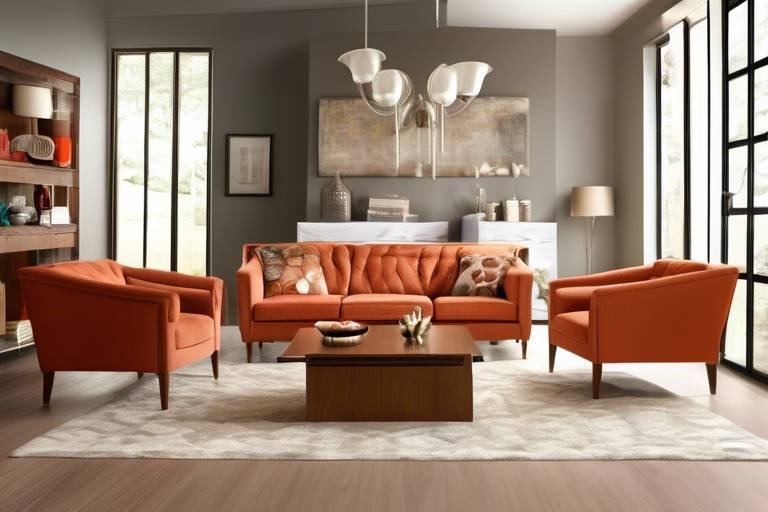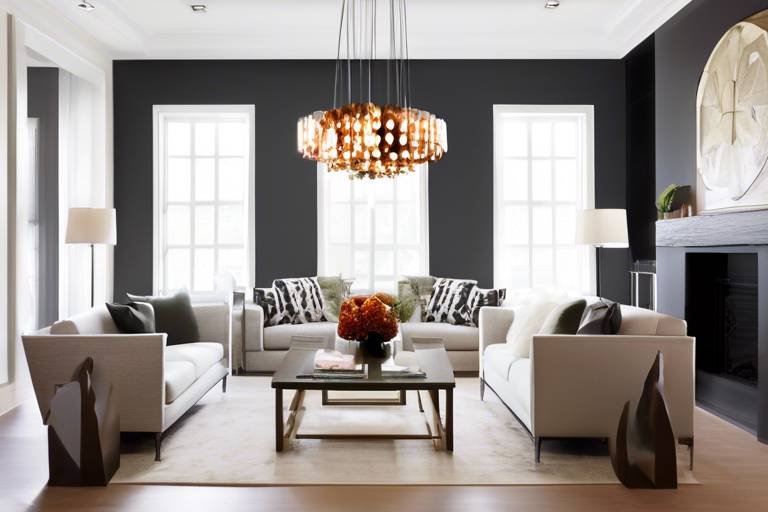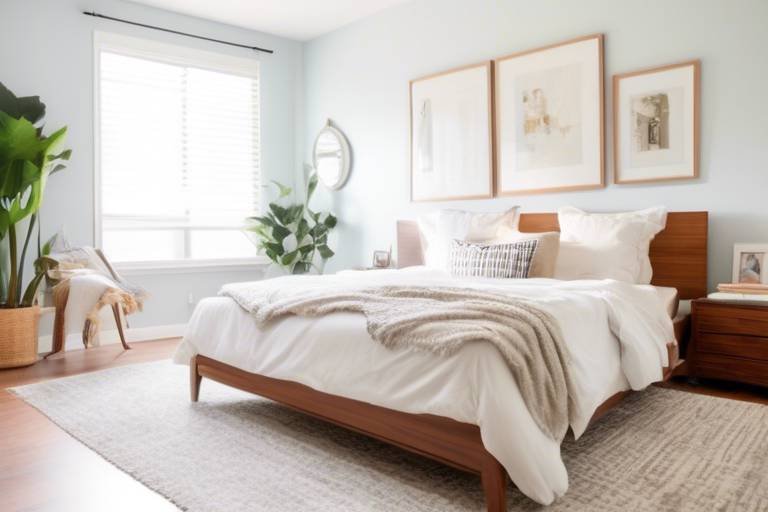How to Integrate Minimalist Principles into Your Home’s Layout
Minimalist design is all about simplicity, functionality, and creating a harmonious living space that promotes peace and relaxation. By incorporating minimalist principles into your home's layout, you can transform your living space into a clutter-free sanctuary that exudes style and sophistication.
One of the first steps in integrating minimalist principles into your home is decluttering your space. Clearing out unnecessary items and organizing your belongings can help create a sense of calm and serenity. By streamlining your possessions, you can focus on the essentials and eliminate distractions that disrupt the flow of your living space.
When it comes to furniture selection, opt for pieces that are not only aesthetically pleasing but also serve a practical purpose. Choose furniture with clean lines and multifunctional features to maximize space and maintain a minimalist aesthetic. Investing in quality pieces that complement your overall design scheme can enhance the visual appeal of your home.
Neutral color schemes play a crucial role in minimalist design, as they create a cohesive and soothing atmosphere. Embracing shades of white, beige, and grey can help unify your space and make it feel more spacious and airy. By sticking to a muted color palette, you can achieve a timeless and elegant look that aligns with minimalist principles.
Incorporating natural elements such as wood, stone, and plants can add warmth and texture to your home while staying true to minimalist ideals. These organic materials bring a sense of tranquility and connection to the outdoors, enhancing the overall ambiance of your living space. By blending nature-inspired elements with modern design, you can create a harmonious environment that promotes relaxation.
Lighting design is another essential aspect of minimalist living. Optimize natural light sources and incorporate ambient lighting to brighten up your space and create a welcoming atmosphere. Proper lighting not only enhances the aesthetic appeal of your home but also influences your mood and well-being, making it a key element in minimalist design.
Functional storage solutions are vital for maintaining a clutter-free environment in a minimalist home. Explore innovative storage options that blend seamlessly with your design aesthetic, such as hidden cabinets, built-in shelves, and multi-purpose furniture. By prioritizing organization and efficiency, you can keep your space tidy and visually appealing.
When it comes to decor accents, less is more in minimalist design. Select simple and elegant pieces that reflect your personal style without overwhelming the space. Incorporate meaningful objects and artwork strategically to add personality and interest to your home while maintaining a clean and uncluttered look.
Creating balance and harmony in your home's layout is key to achieving a cohesive minimalist look. Pay attention to the placement of furniture, decor, and design elements to ensure a sense of equilibrium and flow throughout your space. By thoughtfully arranging each component, you can create a visually pleasing environment that promotes tranquility and simplicity.

Decluttering Your Space
When it comes to creating a minimalist living space, decluttering your home is the first step towards achieving a clean and serene environment. By removing unnecessary items and organizing your belongings, you can create a sense of spaciousness and order that promotes peace of mind.
One effective strategy for decluttering your space is to start room by room, tackling one area at a time to prevent feeling overwhelmed. Evaluate each item and ask yourself if it serves a purpose or brings you joy. If not, consider donating, selling, or discarding it to free up space and reduce visual noise.
Utilizing storage solutions such as sleek cabinets, hidden drawers, and multi-functional furniture can help keep your space organized and clutter-free. By finding designated places for your belongings, you can maintain a tidy environment and prevent unnecessary items from piling up.
Consider implementing a "one in, one out" rule to prevent new clutter from accumulating. Before bringing in a new item, make sure to remove something of equal size or value to maintain a balanced and minimalist living space.
Remember, decluttering is not just about getting rid of things; it's also about creating a sense of calm and openness in your home. By simplifying your surroundings, you can focus on what truly matters and enjoy a more peaceful and harmonious living environment.

Choosing Functional Furniture
When it comes to creating a minimalist living space, choosing functional furniture is key to achieving a sleek and clutter-free environment. Functional furniture pieces not only serve a practical purpose but also contribute to the overall aesthetic of your home. By selecting furniture that can multitask and provide storage solutions, you can maximize the efficiency of your space while maintaining a minimalist design.
One approach to choosing functional furniture is to opt for pieces that offer hidden storage compartments. Coffee tables with built-in drawers or ottomans that can store blankets and pillows are excellent choices for keeping clutter at bay while maintaining a clean look. Additionally, consider furniture that can serve dual purposes, such as a sofa bed or a dining table that can extend to accommodate more guests.
Another aspect to consider when selecting functional furniture is the material and design. Look for pieces that are durable, easy to clean, and have a timeless appeal. Avoid overly ornate or bulky furniture that can overwhelm a minimalist space. Instead, opt for sleek lines, simple shapes, and neutral colors that can effortlessly blend into your overall design scheme.
Furthermore, think about the versatility of each furniture piece. Can it be easily moved or rearranged to adapt to different needs? Flexible furniture arrangements allow you to optimize your space according to various activities, whether it's hosting a gathering or creating a quiet reading nook. Versatile furniture not only adds practicality but also enhances the functionality of your home.

Embracing Neutral Color Schemes
Discover how to incorporate minimalist design concepts into your living space to create a clean, clutter-free environment that promotes relaxation and simplicity.
When it comes to embracing neutral color schemes in your home, think of it as the canvas on which your minimalist design masterpiece will unfold. Neutral colors like soft whites, gentle grays, and soothing beiges form the foundation of a minimalist space, providing a sense of calm and tranquility.
By using neutral colors on your walls, floors, and larger furniture pieces, you create a harmonious backdrop that allows other elements in the room to shine. These colors not only visually expand the space but also create a cohesive look that ties everything together seamlessly.
Consider incorporating textures and subtle patterns in similar neutral tones to add depth and interest without disrupting the minimalist aesthetic. A plush cream area rug, a linen throw pillow, or a sleek matte finish on furniture can all contribute to the overall warmth and sophistication of the space.
Remember, the beauty of neutral color schemes lies in their versatility and timeless appeal. They serve as a blank canvas that allows you to experiment with different accent colors or swap out decor pieces seasonally without losing the essence of your minimalist design.
Q: How can I add pops of color to a neutral color scheme in a minimalist design?
A: You can introduce pops of color through small decor accents such as throw pillows, artwork, or plants. Opt for vibrant hues that complement the neutral palette without overpowering the space.
Q: Is it necessary to stick to a monochromatic color scheme in minimalist design?
A: While monochromatic color schemes are common in minimalist design, you can also experiment with subtle variations of neutral tones or introduce a single accent color for added interest.
Q: How do I maintain the cleanliness of a neutral color scheme in a minimalist home?
A: Regular cleaning and organization are key to preserving the pristine look of a neutral color scheme. Opt for easy-to-clean materials and minimal decor to simplify maintenance.

Incorporating Natural Elements
Discover how to incorporate minimalist design concepts into your living space to create a clean, clutter-free environment that promotes relaxation and simplicity.
When it comes to embracing a minimalist lifestyle in your home, incorporating natural elements is key to achieving a harmonious and serene atmosphere. Natural elements such as wood, stone, and plants not only add warmth and texture to your space but also connect you to the outdoors, bringing a sense of tranquility indoors.
Wooden furniture pieces can infuse a sense of organic beauty into your home, while stone accents can create a grounding effect. Additionally, incorporating indoor plants not only purifies the air but also adds a touch of greenery that enhances the overall aesthetic of your space.
By integrating these natural elements thoughtfully throughout your home, you can create a balanced environment that exudes a sense of peace and simplicity. The combination of these elements with minimalist design principles can elevate the overall look and feel of your living space, making it a truly inviting and calming retreat.

Optimizing Lighting Design
When it comes to creating a minimalist living space, optimizing lighting design plays a crucial role in enhancing the overall ambiance and aesthetic appeal of your home. Proper lighting not only illuminates the space but also contributes to the sense of openness and tranquility that defines minimalist design.
One effective way to optimize lighting in a minimalist home is to maximize natural light sources. Positioning furniture and decor strategically to allow natural light to flow freely throughout the space can create a bright and airy atmosphere. Consider using sheer curtains or light-filtering blinds to maintain privacy while still allowing ample natural light to enter the room.
In addition to natural light, incorporating layered lighting fixtures can help create a versatile lighting scheme that can be adjusted to suit different activities and moods. Ambient lighting, task lighting, and accent lighting can be combined to provide both functionality and aesthetics in a minimalist setting.
Choosing light fixtures with clean lines and simple designs can complement the minimalist aesthetic of your home. Opt for fixtures that blend seamlessly with the overall decor scheme and avoid overly ornate or elaborate designs that may disrupt the clean and streamlined look you are trying to achieve.
Consider the color temperature of the light bulbs you use to ensure they create the desired atmosphere in each room. Cool white light can promote alertness and productivity in workspaces, while warm white or soft yellow light can create a cozy and inviting feel in living areas.
Finally, don't underestimate the impact of lighting control systems in optimizing the lighting design of your home. Dimmer switches, smart lighting solutions, and programmable timers can all help you adjust the lighting levels according to your needs and preferences, allowing you to create the perfect ambiance for any occasion.

Creating Functional Storage Solutions
When it comes to creating functional storage solutions in your home, it's essential to prioritize both practicality and aesthetics. One effective approach is to maximize the use of multi-functional furniture pieces that offer hidden storage compartments, such as ottomans with built-in storage or bed frames with drawers underneath. These pieces not only serve their primary purpose but also help keep your space organized and clutter-free.
Another strategy for enhancing storage in a minimalist setting is to utilize vertical space efficiently. Consider installing floating shelves or wall-mounted cabinets to store items without taking up valuable floor space. These sleek storage solutions not only provide additional storage capacity but also contribute to the overall minimalist aesthetic by keeping surfaces clear and uncluttered.
Additionally, incorporating modular storage units can be a game-changer in optimizing space while maintaining a minimalist look. These customizable units allow you to adapt the storage configuration to suit your specific needs, whether it's storing books, displaying decor items, or organizing personal belongings. By investing in versatile storage systems, you can ensure that every item in your home has its designated place, promoting a sense of order and tranquility.
Furthermore, integrating hidden storage options into your home's design can help conceal everyday items and maintain a streamlined appearance. Consider incorporating storage solutions such as built-in cabinets, pull-out drawers, or sliding doors that blend seamlessly with the overall design of your space. Concealed storage not only reduces visual clutter but also adds a touch of sophistication to your home's interior.
Lastly, don't overlook the potential of dual-purpose furniture that combines storage functionality with stylish design elements. For example, a coffee table with integrated storage compartments or a bench with lift-up seats can serve as practical storage solutions while adding visual interest to your living area. By strategically incorporating these pieces into your home, you can achieve a harmonious balance between functionality and aesthetics within a minimalist framework.

Implementing Simple Decor Accents
When it comes to implementing simple decor accents in your home, less is often more. The key to achieving a minimalist look while adding personality and style lies in selecting a few carefully curated pieces that make a statement without overwhelming the space. Consider incorporating artwork with clean lines and neutral colors to complement the serene atmosphere of a minimalist design.
Textiles such as throw pillows, rugs, and curtains can also serve as simple decor accents that add warmth and texture to your living space. Opt for high-quality fabrics in muted tones to maintain a cohesive look that aligns with minimalist principles. Additionally, plants can bring life and a touch of nature indoors, enhancing the overall ambiance of the room.
When selecting decorative objects, opt for items that have a purpose and contribute to the overall aesthetic of the room. Minimalist decor accents should be thoughtfully chosen and displayed in a way that complements the clean lines and simplicity of the space. Remember, the goal is to create a harmonious environment that promotes relaxation and tranquility.

Maintaining Balance and Harmony
When it comes to creating a minimalist home, maintaining balance and harmony is key to achieving a cohesive and visually pleasing space. The arrangement of furniture, decor, and design elements plays a significant role in the overall feel of your home. Imagine your space as a carefully orchestrated symphony, with each piece working together harmoniously to create a sense of tranquility and order.
One way to maintain balance in your home is to carefully consider the scale and proportion of furniture and decor items. Avoid overcrowding a room with too many large pieces, as this can create a sense of imbalance and overwhelm the space. Instead, opt for a few well-chosen pieces that complement each other in size and shape.
Another important aspect of achieving balance and harmony in a minimalist home is through the use of symmetry. Symmetrical arrangements can create a sense of stability and order, making a space feel more organized and visually appealing. Consider placing matching elements on either side of a central focal point to create a sense of balance in a room.
Color also plays a crucial role in maintaining balance within your home. Choose a limited color palette that complements the minimalist aesthetic, avoiding overly bright or clashing colors that can disrupt the harmony of a space. Soft neutrals and muted tones can help create a sense of calm and cohesion throughout your home.
Incorporating elements of nature, such as plants or natural materials, can also contribute to a sense of balance and harmony in your home. Bringing the outdoors in can add a touch of warmth and texture to a space, creating a connection to the natural world that promotes a sense of peace and tranquility.
Remember, achieving balance and harmony in your home is not about strict adherence to rules, but rather about creating a space that feels comfortable and inviting to you. Experiment with different arrangements and design elements until you find a balance that resonates with your personal style and enhances the minimalist aesthetic of your home.
Frequently Asked Questions
- What is minimalist design?
Minimalist design is a style that focuses on simplicity, clean lines, and a clutter-free environment. It emphasizes the use of essential elements and a minimalist color palette to create a sense of calm and tranquility in living spaces.
- How can I declutter my home effectively?
To declutter your home effectively, start by sorting through your belongings and getting rid of items you no longer need or use. Utilize storage solutions to organize remaining items and maintain a clutter-free environment.
- Why are neutral color schemes important in minimalist design?
Neutral color schemes are crucial in minimalist design as they create a sense of unity, simplicity, and serenity in a space. Neutral colors such as white, beige, and gray help to maintain a clean and cohesive look in minimalist interiors.
- What are some examples of natural elements in minimalist design?
Examples of natural elements in minimalist design include wood furniture, stone accents, and indoor plants. These elements add warmth, texture, and a connection to nature in a minimalist living space.
- How can I optimize lighting in a minimalist home?
To optimize lighting in a minimalist home, maximize natural light sources, use light-colored window treatments, and incorporate layered lighting fixtures such as ambient, task, and accent lighting to create a bright and airy atmosphere.
- What are some simple decor accents suitable for a minimalist design scheme?
Simple decor accents for a minimalist design scheme include geometric shapes, monochromatic artwork, and functional pieces with clean lines. These accents add personality and style to a space without overwhelming the minimalist aesthetic.



















